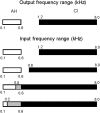Integration of acoustic and electric hearing is better in the same ear than across ears
- PMID: 28970567
- PMCID: PMC5624923
- DOI: 10.1038/s41598-017-12298-3
Integration of acoustic and electric hearing is better in the same ear than across ears
Abstract
Advances in cochlear implant (CI) technology allow for acoustic and electric hearing to be combined within the same ear (electric-acoustic stimulation, or EAS) and/or across ears (bimodal listening). Integration efficiency (IE; the ratio between observed and predicted performance for acoustic-electric hearing) can be used to estimate how well acoustic and electric hearing are combined. The goal of this study was to evaluate factors that affect IE in EAS and bimodal listening. Vowel recognition was measured in normal-hearing subjects listening to simulations of unimodal, EAS, and bimodal listening. The input/output frequency range for acoustic hearing was 0.1-0.6 kHz. For CI simulations, the output frequency range was 1.2-8.0 kHz to simulate a shallow insertion depth and the input frequency range was varied to provide increasing amounts of speech information and tonotopic mismatch. Performance was best when acoustic and electric hearing was combined in the same ear. IE was significantly better for EAS than for bimodal listening; IE was sensitive to tonotopic mismatch for EAS, but not for bimodal listening. These simulation results suggest acoustic and electric hearing may be more effectively and efficiently combined within rather than across ears, and that tonotopic mismatch should be minimized to maximize the benefit of acoustic-electric hearing, especially for EAS.
Conflict of interest statement
The authors declare that they have no competing interests.
Figures




Similar articles
-
Effect of carrier bandwidth on integration of simulations of acoustic and electric hearing within or across ears.J Acoust Soc Am. 2017 Dec;142(6):EL561. doi: 10.1121/1.5017530. J Acoust Soc Am. 2017. PMID: 29289073 Free PMC article.
-
Effects of noise on integration of acoustic and electric hearing within and across ears.PLoS One. 2020 Oct 15;15(10):e0240752. doi: 10.1371/journal.pone.0240752. eCollection 2020. PLoS One. 2020. PMID: 33057396 Free PMC article.
-
Speech perception with combined electric-acoustic stimulation and bilateral cochlear implants in a multisource noise field.Ear Hear. 2013 May-Jun;34(3):324-32. doi: 10.1097/AUD.0b013e318272f189. Ear Hear. 2013. PMID: 23263408
-
Electroacoustic Stimulation.Otolaryngol Clin North Am. 2019 Apr;52(2):311-322. doi: 10.1016/j.otc.2018.11.008. Epub 2019 Jan 5. Otolaryngol Clin North Am. 2019. PMID: 30617011 Review.
-
An overview of factors affecting bimodal and electric-acoustic stimulation (EAS) speech understanding outcomes.Hear Res. 2023 Apr;431:108736. doi: 10.1016/j.heares.2023.108736. Epub 2023 Mar 5. Hear Res. 2023. PMID: 36931019 Review.
Cited by
-
A Level-Adjusted Cochlear Frequency-to-Place Map for Estimating Tonotopic Frequency Mismatch With a Cochlear Implant.Ear Hear. 2025 Jul-Aug 01;46(4):963-975. doi: 10.1097/AUD.0000000000001641. Epub 2025 Feb 11. Ear Hear. 2025. PMID: 39930567
-
Integration of fundamental frequency and voice-onset-time to voicing categorization: Listeners with normal hearing and bimodal hearing configurations.J Acoust Soc Am. 2023 Mar;153(3):1580. doi: 10.1121/10.0017429. J Acoust Soc Am. 2023. PMID: 37002096 Free PMC article.
-
Hybrid Music Perception Outcomes: Implications for Melody and Timbre Recognition in Cochlear Implant Recipients.Otol Neurotol. 2019 Mar;40(3):e283-e289. doi: 10.1097/MAO.0000000000002126. Otol Neurotol. 2019. PMID: 30741908 Free PMC article.
-
Effect of carrier bandwidth on integration of simulations of acoustic and electric hearing within or across ears.J Acoust Soc Am. 2017 Dec;142(6):EL561. doi: 10.1121/1.5017530. J Acoust Soc Am. 2017. PMID: 29289073 Free PMC article.
-
Effect of Place-Based Versus Default Mapping Procedures on Masked Speech Recognition: Simulations of Cochlear Implant Alone and Electric-Acoustic Stimulation.Am J Audiol. 2022 Jun 2;31(2):322-337. doi: 10.1044/2022_AJA-21-00123. Epub 2022 Apr 8. Am J Audiol. 2022. PMID: 35394798 Free PMC article.
References
Publication types
MeSH terms
LinkOut - more resources
Full Text Sources
Other Literature Sources

